Nice workmanship, I do look forward to seeing your builds very nice, I have just finished a scratch built Gauge 1 merchant navy, I could not get the cab profile looking right at all, After a few attempts i went for the series 2 cab, much easier to make, but not as good to the eye as this cab version.
You are using an out of date browser. It may not display this or other websites correctly.
You should upgrade or use an alternative browser.
You should upgrade or use an alternative browser.
7mm Mickoo's Commercial Workbench
- Thread starter mickoo
- Start date
simond
Western Thunderer
That’s a nice bit of work.
I was very pleased with my “slidebar assembly jig” prints, as they made a fiddly job much easier, and I will certainly think of printing something next time I have a similar challenge. It also appears that soldering temperatures (at least briefly) don’t seem to trouble the resin, which is handy to know - picked that gem up from the Templot forum.
Atb
Simon
I was very pleased with my “slidebar assembly jig” prints, as they made a fiddly job much easier, and I will certainly think of printing something next time I have a similar challenge. It also appears that soldering temperatures (at least briefly) don’t seem to trouble the resin, which is handy to know - picked that gem up from the Templot forum.
Atb
Simon
Lancastrian
Western Thunderer
Schools, N15, S15, H15, N, U, K etc could do with them.There must be a market for cab formers.
Dave
mickoo
Western Thunderer
Careful, I am a member of the secret master dabbler sectThe Bulleids look superb Mick ,and I am learning a lot from what you do
John


Clarence3815
Western Thunderer
As in Argentinian racing pigeon?
mickoo
Western Thunderer
End of the week update, rather better progress from previous weeks but not quite where I wanted to be at the end of play, but not much more to do, despite appearances.
The rear end of the casing needs a tweak, it's a smidge too wide (0.2 mm) at the base; this isn't unusual give the tolerances of etches and sometimes the original resin casing required a tweak to the cab front to match the profile.
It'll be a simple case of taking the rear bulkhead out of the casing, wafting the file over it and reinserting. The cylinder block needs a tweak to give a perfect fit along the bottom of the casing; all normal stuff in the course of things.
There's a couple of details to go on the cab roof and some gap filling to sort. I do need to take my pipework bracket floors out, or at least cut them to clear the openings in the cab sides; then add the associated detail in the cavity. Finally the injector pipework can go in and the rear end will be complete.
In the casing are two more apertures so I'll need to 3D the lower base of the firebox and front section of the boiler to give the inner depths some mass, then add the associated detail in front.
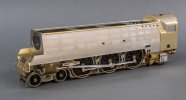
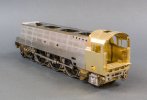
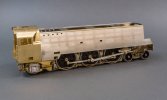
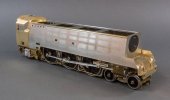
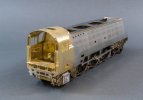
The rear end of the casing needs a tweak, it's a smidge too wide (0.2 mm) at the base; this isn't unusual give the tolerances of etches and sometimes the original resin casing required a tweak to the cab front to match the profile.
It'll be a simple case of taking the rear bulkhead out of the casing, wafting the file over it and reinserting. The cylinder block needs a tweak to give a perfect fit along the bottom of the casing; all normal stuff in the course of things.
There's a couple of details to go on the cab roof and some gap filling to sort. I do need to take my pipework bracket floors out, or at least cut them to clear the openings in the cab sides; then add the associated detail in the cavity. Finally the injector pipework can go in and the rear end will be complete.
In the casing are two more apertures so I'll need to 3D the lower base of the firebox and front section of the boiler to give the inner depths some mass, then add the associated detail in front.





James Spooner
Western Thunderer
End of the week update, rather better progress from previous weeks but not quite where I wanted to be at the end of play, but not much more to do, despite appearances.
The rear end of the casing needs a tweak, it's a smidge too wide (0.2 mm) at the base; this isn't unusual give the tolerances of etches and sometimes the original resin casing required a tweak to the cab front to match the profile.
It'll be a simple case of taking the rear bulkhead out of the casing, wafting the file over it and reinserting. The cylinder block needs a tweak to give a perfect fit along the bottom of the casing; all normal stuff in the course of things.
There's a couple of details to go on the cab roof and some gap filling to sort. I do need to take my pipework bracket floors out, or at least cut them to clear the openings in the cab sides; then add the associated detail in the cavity. Finally the injector pipework can go in and the rear end will be complete.
In the casing are two more apertures so I'll need to 3D the lower base of the firebox and front section of the boiler to give the inner depths some mass, then add the associated detail in front.
View attachment 212411
View attachment 212412
View attachment 212413
View attachment 212414
View attachment 212415
david duxbury
Member
34079? looking excellent!
Pencarrow
Western Thunderer
End of the week update, rather better progress from previous weeks but not quite where I wanted to be at the end of play, but not much more to do, despite appearances.
The rear end of the casing needs a tweak, it's a smidge too wide (0.2 mm) at the base; this isn't unusual give the tolerances of etches and sometimes the original resin casing required a tweak to the cab front to match the profile.
It'll be a simple case of taking the rear bulkhead out of the casing, wafting the file over it and reinserting. The cylinder block needs a tweak to give a perfect fit along the bottom of the casing; all normal stuff in the course of things.
There's a couple of details to go on the cab roof and some gap filling to sort. I do need to take my pipework bracket floors out, or at least cut them to clear the openings in the cab sides; then add the associated detail in the cavity. Finally the injector pipework can go in and the rear end will be complete.
In the casing are two more apertures so I'll need to 3D the lower base of the firebox and front section of the boiler to give the inner depths some mass, then add the associated detail in front.
View attachment 212411
View attachment 212412
View attachment 212413
View attachment 212414
View attachment 212415
Sawn-off Bulleid, love it.
Pencarrow
Western Thunderer
It would need a 9' wide cab to be '7934079? looking excellent!
mickoo
Western Thunderer
To move forward, you must sometimes move backward, Bulleid firebox and ash pan.
The kit ash pan flange plate only covers the front 2/3rds, that under the cab is none existent, not a problem until you deviate off the yellow brick road, in addition the side sheets have an odd kink in the upper edge, it's there for a reason, I just haven't found out what that is yet.
Nevertheless the top section needs removing and rebuilding, the flange plate is extended to the rear and new side sheets fitted along with a new floor over the delta track area. That allowed the pipe fixing brackets to be added; they'll be cut back once the pipework and securing clip is fitted.
Then it was time to 3D the new firebox base. In an ideal world it'd be one module, but the cab front/casing rear bulkheads impose and it's a lot of work to hack those back to give clearance this late in the build.
Currently the modules are just held in with double sided tape for visual checks; I can already see that the front section perhaps needs to move forward about 1.0 mm. Plus, the gap twixt firebox and casing is uncomfortably tight to get the pipework up there, so both sections will need their widths reduced by 0.4 mm each side. I've also spotted that the stay bolt heads are not the same height on each module (since corrected and in the printer along with the rest of the tweaks).
That will of course expose more of the flange plate which still has the tab holes for the original metal firebox base, which incidentally is a flat base and the real thing is rounded quite significantly.
The up shot is that for future builds I'll leave off the kit firebox base and fit the 3D version with the rounded base, even without open panels the base at the front is still visible below the casing so the effort will be worth it. I may also get new side sheets flange plates and floor sections etched up as that'll save several hours modifying and scratch building the replacement parts.
Once I'm happy with the placement and fit I'll solder small hoops of wire in the oval holes and then fill with adhesive, that'll bond to the hoops and resin module for a nice strong fix.
The final part will be to add some lagging higher up the side of the firebox and under the base of the boiler, I have a few ideas for that so we;ll see if they work or not. If it does then I'll add a brass belly for the boiler and lag that to cover the gap from front to rear.
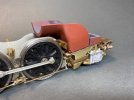
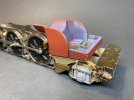
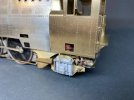
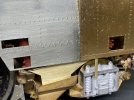
The kit ash pan flange plate only covers the front 2/3rds, that under the cab is none existent, not a problem until you deviate off the yellow brick road, in addition the side sheets have an odd kink in the upper edge, it's there for a reason, I just haven't found out what that is yet.
Nevertheless the top section needs removing and rebuilding, the flange plate is extended to the rear and new side sheets fitted along with a new floor over the delta track area. That allowed the pipe fixing brackets to be added; they'll be cut back once the pipework and securing clip is fitted.
Then it was time to 3D the new firebox base. In an ideal world it'd be one module, but the cab front/casing rear bulkheads impose and it's a lot of work to hack those back to give clearance this late in the build.
Currently the modules are just held in with double sided tape for visual checks; I can already see that the front section perhaps needs to move forward about 1.0 mm. Plus, the gap twixt firebox and casing is uncomfortably tight to get the pipework up there, so both sections will need their widths reduced by 0.4 mm each side. I've also spotted that the stay bolt heads are not the same height on each module (since corrected and in the printer along with the rest of the tweaks).
That will of course expose more of the flange plate which still has the tab holes for the original metal firebox base, which incidentally is a flat base and the real thing is rounded quite significantly.
The up shot is that for future builds I'll leave off the kit firebox base and fit the 3D version with the rounded base, even without open panels the base at the front is still visible below the casing so the effort will be worth it. I may also get new side sheets flange plates and floor sections etched up as that'll save several hours modifying and scratch building the replacement parts.
Once I'm happy with the placement and fit I'll solder small hoops of wire in the oval holes and then fill with adhesive, that'll bond to the hoops and resin module for a nice strong fix.
The final part will be to add some lagging higher up the side of the firebox and under the base of the boiler, I have a few ideas for that so we;ll see if they work or not. If it does then I'll add a brass belly for the boiler and lag that to cover the gap from front to rear.




Martin Shaw
Western Thunderer
I don't think I've ever seen washout plugs and a mudhole door modelled so convincingly. Well done Mick.
Martin
Martin
Dave Holt
Western Thunderer
Yes, wonderful to see. The real things are the devil's own job to get in or out. You'd think an elliptical door would easily pass through an elliptical opening by simply aligning the short axis of the mud hole door with the long axis of the hole, but the fixing stud gets in the way.
Dave.
Dave.
mickoo
Western Thunderer
I know all to well, not from steam engines but industrial/commercial boilers, hot water tanks and pressure vessels, they have the exact same fitting and profile, most of them had a cardboard gasket (pressure vessels) with no sealant so you're juggling that into place as well, if you added any sealant there was a real risk of the gasket slipping/moving or worse yet tearing when you torqued it down.Yes, wonderful to see. The real things are the devil's own job to get in or out. You'd think an elliptical door would easily pass through an elliptical opening by simply aligning the short axis of the mud hole door with the long axis of the hole, but the fixing stud gets in the way.
Dave.
Others had a recess and a rope gasket (usually boilers), there was a special way to cross over the ends to give as uniform profile as possible but I can't remember what it was or how to do it 30 years on. We were allowed to use high temp graphite grease on the rope to help seal the joint but only a thin smear.
Oh happy days, especially when you dropped it into a 2m dia domed bottom pressure vessel, too far to reach by hand so you ended up using all sorts of inspector gadget implements to get hold of said dropped pieces and retrieve them.
Last edited:
david duxbury
Member
Been there, got the tee shirt on compressed air and vacuum vessels many with two clamp fixings and heavy doors.I know all to well, not from steam engines but industrial/commercial boilers, hot water tanks and pressure vessels, they have the exact same fitting and profile, most of them had a cardboard gasket (pressure vessels) with no sealant so you're juggling that into place as well, if you added any sealant there was a real risk of the gasket slipping/moving or worse yet tearing when you torqued it down.
Others had a recess and a rope gasket (usually boilers), there was a special way to cross over the ends to give as uniform profile as possible but I can't remember what it was or how to do it 30 years on. We were allowed to use high temp graphite grease on the rope to help seal the joint but only a thin smear.
Oh happy days, especially when you dropped it into a 2m dia domed bottom pressure vessel, too far to reach by hand so you ended up using all sorts of inspector gadget implements to get hold of said dropped pieces and retrieve them.
Dave
James Spooner
Western Thunderer
Crikey Mick, that is seriously impressive stuff; you’ll be modelling the thermic siphons next!
Nigel
Nigel
